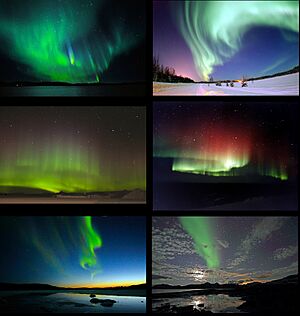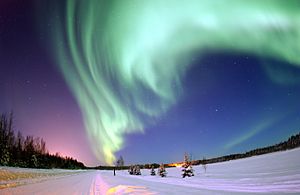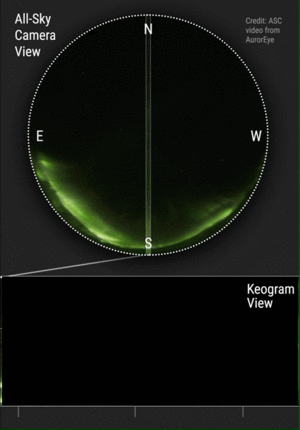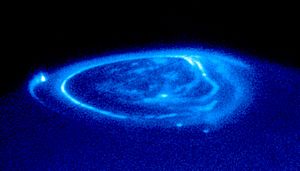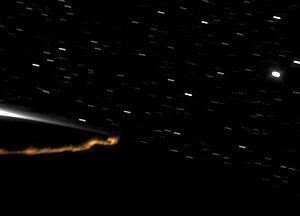Aurora facts for kids
An aurora is a beautiful natural light show in the sky. People also call them polar lights, northern lights, or southern lights. You usually see them in areas close to the Earth's poles, like the Arctic and Antarctic. Auroras happen when the Earth's magnetosphere (its magnetic shield) is affected by tiny particles from the solar wind.
An aurora near the North Pole is known as the Aurora borealis, or 'northern lights'. Near the South Pole, it's called the Aurora australis, or 'southern lights'. These amazing lights can stretch for hundreds of miles across the sky!
Auroras can happen at any time, but you can only see them at night. Their light isn't as strong as daylight. You can even see faint stars shining through an aurora. Many old stories and legends are connected to the aurora in places where it appears often.
Contents
What does "Aurora" mean?
The name aurora borealis was first used by a scientist named Galileo in 1619. He got the name from the Roman goddess of the dawn, Aurora. The word borealis comes from the Greek name for the north wind, Boreas.
So, the word aurora comes from the Roman goddess of the dawn. She was believed to travel from east to west, announcing the sun's arrival. The words borealis and australis come from the ancient Greek gods of the north wind (Boreas) and the south wind (Auster).
How do Auroras Happen?
Imagine the sun as a huge, powerful lightbulb. It doesn't just give us light and warmth. It also sends out tiny particles called solar wind. This solar wind is made of electrons and protons. These are super tiny bits of matter that zoom through space.
When the solar wind reaches Earth, most of it bounces away. This is thanks to Earth's magnetic field. It acts like an invisible shield around our planet. But some of these particles get caught by the magnetic field. They are then guided towards the Earth's poles. This means the North Pole and the South Pole.
As these particles rush towards the poles, they crash into gases in Earth's atmosphere. These gases include oxygen and nitrogen. The collisions are like tiny bumper cars hitting each other! When these crashes happen, they release energy. This energy shows up as light. This light is what we see as the amazing aurora!
Why are Auroras Different Colors?
The colors of the aurora depend on a few things. It depends on which gas particles are hit. It also depends on how high up in the atmosphere the collisions happen.
- Green: This is the most common aurora color. It happens when solar wind particles hit oxygen. This happens at lower heights, about 60 miles up.
- Red: Red auroras appear when solar wind particles hit oxygen. This happens at much higher heights, over 200 miles up.
- Blue and Purple: These colors are made when solar wind particles hit nitrogen.
When is the Best Time to See the Aurora?
The best time to see the aurora is during the winter months. This is from September to April in the Northern Hemisphere. It's from March to September in the Southern Hemisphere. Nights are longer and darker then. This makes it easier to see the faint aurora light.
You also need a clear, dark sky. Get away from city lights if you can. Light pollution from cities makes it hard to see the aurora.
Another key thing is solar activity. The more active the sun is, the brighter and more active the aurora will likely be. Scientists can predict solar activity. So, you can check the aurora forecast before you go aurora hunting!
Where do Auroras Appear?
Most auroras show up in a special area called the "auroral zone." This zone is usually about 3° to 6° wide in latitude. It's found between 10° and 20° away from the geomagnetic poles. You can see it best at night when the sky is dark. A place that has an aurora right now is called the "auroral oval." This band is pushed towards Earth's night side by the solar wind.
In northern latitudes, we call it the aurora borealis, or northern lights. The southern version is the aurora australis, or southern lights. It looks almost exactly like the northern lights. It also changes at the same time as the northern auroral zone. You can see the aurora australis from places like Antarctica, Chile, Argentina, South Africa, New Zealand, and Australia. The aurora borealis is visible from areas around the Arctic. These include Alaska, the Canadian Territories, Iceland, Greenland, Norway, Sweden, Finland, Scotland, and Siberia. Sometimes, the aurora borealis can even be seen as far south as the Mediterranean Sea and the southern parts of the US.
Fun Facts About the Aurora
- Auroras can look like many different shapes. They can be arcs, bands, curtains, or rays.
- Sometimes, people say auroras make sounds! They have reported hearing crackling, hissing, or popping noises. These sounds happen during very strong aurora displays. But scientists are still trying to understand them.
- The strongest aurora ever seen was during the Carrington Event in 1859. This happened because of a huge solar flare. The aurora was visible as far south as Cuba and Hawaii!
- Other planets in our solar system also have auroras! These include Jupiter and Saturn.
- You can even see auroras from space! Astronauts on the International Space Station have taken amazing pictures of the aurora from above.
Images for kids
See also
 In Spanish: Aurora polar para niños
In Spanish: Aurora polar para niños


